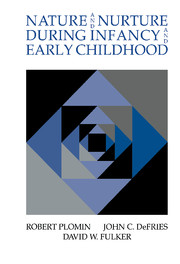Book contents
- Frontmatter
- Contents
- Preface
- Acknowledgments
- 1 Introduction
- 2 Individual differences and group differences
- 3 Quantitative genetics as the basis for a general theory of individual differences
- 4 The Colorado Adoption Project
- 5 Transitions and changes: description and prediction
- 6 Transitions and changes: genetic and environmental etiologies
- 7 Introduction to model fitting
- 8 Fitting sibling and parent–offspring models in the Colorado Adoption Project
- 9 Interactions
- 10 Genotype–environment correlation
- 11 Genetics and measures of the family environment: the nature of nurture
- 12 Conclusions
- References
- Author index
- Subject index
8 - Fitting sibling and parent–offspring models in the Colorado Adoption Project
Published online by Cambridge University Press: 15 October 2009
- Frontmatter
- Contents
- Preface
- Acknowledgments
- 1 Introduction
- 2 Individual differences and group differences
- 3 Quantitative genetics as the basis for a general theory of individual differences
- 4 The Colorado Adoption Project
- 5 Transitions and changes: description and prediction
- 6 Transitions and changes: genetic and environmental etiologies
- 7 Introduction to model fitting
- 8 Fitting sibling and parent–offspring models in the Colorado Adoption Project
- 9 Interactions
- 10 Genotype–environment correlation
- 11 Genetics and measures of the family environment: the nature of nurture
- 12 Conclusions
- References
- Author index
- Subject index
Summary
In this chapter we report results from model-fitting analyses of data from the Colorado Adoption Project using the simple sibling and parent–off-spring models developed in the preceding chapter as well as extending the model to include age-to-age genetic correlations and to consider the multivariate case. As discussed in Chapter 7, model fitting has several advantages over less sophisticated approaches to the interpretation of behavioral genetic data: It yields appropriate parameter estimates given the assumptions of a model; it provides standard errors for these parameter estimates; and it provides goodness-of-fit tests to aid in the evaluation of alternative models.
Sibling model
A simple model can be used to represent the sibling adoption design because the essence of this design lies in the comparison between two correlations: the correlations for adoptive and nonadoptive siblings. The sibling model, illustrated in the path diagram of Figure 7.3, was applied to the adoptive- and nonadoptive-sibling correlations presented in Chapter 6. The model involves only three parameters: heritability and shared and nonshared environment. As specified in Equations (7.4) and (7.5), the model assumes that the observed nonadoptive-sibling correlation is a function of half the heritability of the trait and of shared environmental influence; the adoptive-sibling correlation arises only from shared environmental influence – in the absence of selective placement, heredity does not contribute to the resemblance of adoptive siblings.
- Type
- Chapter
- Information
- Nature and Nurture during Infancy and Early Childhood , pp. 179 - 223Publisher: Cambridge University PressPrint publication year: 1988



